
![]()
Search the Journey to Forever website – click HERE
|
Journey to Forever: Make a donation |
Navigation
| Small farms library | |
| City farms | |
| Organic gardening | |
| Journey to Forever organic garden Handmade soil Village development |
|
| Why organic? | |
| Do it for selfish reasons No pesticides Food quality |
|
| Building a square foot garden | |
| Where to build it Is the soil fertile enough? Raised beds and double-digging The lazy way Paths The sides Sizes and shapes Trellises Cement Soil No compost? |
|
| Plant spacing guides | |
| No ground? Use containers | |
| Container gardening guide Resources |
|
| When to sow what | |
| Sowing times for different regions Seed sowing and harvesting times for Hong Kong Vegetable Garden Calendar for Hong Kong |
|
| Seeds | |
| Catalogs Supplies Herbs Hong Kong |
|
| Garden pond | |
| Pond resources | |
| Gardening resources | |
| Organics resources | |
| Square foot gardens | |
| Companion planting | |
| How much to grow? | |
| General gardening | |
| Herbs | |
| Composting | |
| Small farms | |
Contact usTo Keith Addison Handmade Projects |
No ground? Use containers
You can grow plants in virtually anything that holds some soil and has holes in the bottom for drainage. It's only bounded by your imagination -- a chance for some really creative recycling. Grow a pillar of vegetables -- 12 square feet of growing area on only 1.2 sq ft of ground. See Growing columns.
Container gardening
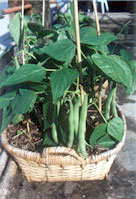
Bushbeans in a special square foot basket, light and easy to carry -- ideal for schools with no grounds to start gardening projects.
Container gardening resources
City rooftop gardens
City rooftop garden resources
Container gardening
We use old bathtubs, 20-litre plastic containers with the tops cut off, baskets of various sizes lined with garbage bags to hold the water in, milk cartons for seedlings, anything that comes to hand. We almost used some dumped toilet bowls, only we didn't like the color (pink).
-- "You can raise a surprising amount of food on your roof, deck, patio or windowsill. The rewards can be large, even if your space is small" -- Chuck Crandall and Barbara Crandall, "Movable Harvests"
Container gardens help to feed the poor in Third World cities -- see City farms.
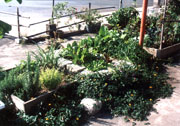 We stuck three sprigs of Creeping Buttercup in a gaily-painted enamel Chinese chamber pot with some holes drilled in the bottom. Now it forms a border round all the growing beds and beyond -- what we call our "lawn". It seems to make its own soil on the cement, catching dust and sand with its hardy roots, it survives trampling and typhoons, and provides a lot of compost material -- and no, it doesn't invade the beds. The chamber pot's still there, discreetly hidden from view behind the granite rock in the foreground -- and by the buttercups.
We stuck three sprigs of Creeping Buttercup in a gaily-painted enamel Chinese chamber pot with some holes drilled in the bottom. Now it forms a border round all the growing beds and beyond -- what we call our "lawn". It seems to make its own soil on the cement, catching dust and sand with its hardy roots, it survives trampling and typhoons, and provides a lot of compost material -- and no, it doesn't invade the beds. The chamber pot's still there, discreetly hidden from view behind the granite rock in the foreground -- and by the buttercups.
Container gardening resources
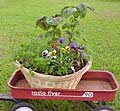 Gardening in Containers: Growing in Small and Soilless Spaces, US National Gardening Association, Growing Ideas Classroom Projects, 2003 -- Detailed practical guide online, designed for teachers to use in school gardening projects, useful for anyone. Background, creative containers, plants and schemes, plants for container gardens, special container projects, recommended web sites, books and tools. Chart of vegetables, showing good container varieties, container size, final plant spacing, light requirement, minimum soil depth. Also herbs, annual flowers, bulbs, perennials. 3 web pages, 5,000 words. Online:
Gardening in Containers: Growing in Small and Soilless Spaces, US National Gardening Association, Growing Ideas Classroom Projects, 2003 -- Detailed practical guide online, designed for teachers to use in school gardening projects, useful for anyone. Background, creative containers, plants and schemes, plants for container gardens, special container projects, recommended web sites, books and tools. Chart of vegetables, showing good container varieties, container size, final plant spacing, light requirement, minimum soil depth. Also herbs, annual flowers, bulbs, perennials. 3 web pages, 5,000 words. Online:
http://www.kidsgardening.com/growingideas/PROJECTS/feb03/pg1.html
"Above-Ground Gardens" by Dr. Martin L. Price & Laura S. Meitzner, 1996, ECHO Technical Note (reprinted from Ch 17 of ECHO's book Amaranth to Zai Holes, 1996), Educational Concerns for Hunger Organization (ECHO)
Urban food production is often overlooked by development planners. There is considerable potential to involve millions of city families in food production, who may not at first seem to have anywhere to garden -- where there is plenty of sunshine but either no soil or the soil does not lend itself to cultivation. "Above-ground" techniques can fit the countless hectares of sturdy, flat cement rooftops and many more hectares of tin roofs on insubstantial shanties, steep hillsides, extremely poor soils, yards of rock or cement, spaces around tree roots, and places where land tenure is so unstable that only portable gardens are attractive. Download (Acrobat file):
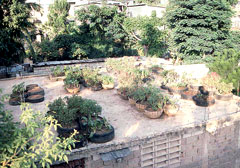
Urban farming in Haiti -- AGUILA Urban Agriculture Research Network Latin America
http://www.echotech.org/mambo/images/DocMan/Abovegro.pdf
Full-length version, in Amaranth to Zai Holes:
http://www.echotech.org/technical/az/aztext/azch17.htm
GardenGuides' Container Gardening Guide Sheets are a useful source of instant information: 21 different guides. The two-page basic Guide to Container Gardening covers Choosing containers, Growing mixture, Sunlight, Fertilizer, Watering, What to grow? on the first page, while the second page deals with vegetables: common vegetables listed with type of container and recommended variety, linked to references on each vegetable covering types, conditions, maintenance and harvest, pests, recipes and useful links. The website has hundreds of other guides on all aspects of gardening, and further resources. Guide to Container Gardening:
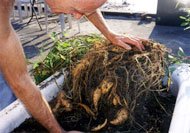
Harvesting sweet potatoes from a bathtub
http://www.gardenguides.com/TipsandTechniques/container.htm
Vegetables in Containers:
http://www.gardenguides.com/TipsandTechniques/container2.htm
Container Farming -- Organic food production in the slums of Mexico City. Fifteen million Mexicans live in extreme poverty -- above all in urban marginal areas like the slums of Mexico City. Some seven years ago a group of NGOs launched a project to help people there to grow their own food organically in small backyards or patios, balconies, roof tops -- as a way to help counteract the poverty being imposed upon them. This is the report on the project, by sociologist and community worker Rodrigo A. Medellín Erdmann.
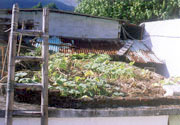
Pumpkins happily growing on the roof of the Beach House kitchen
Container Gardening forum at Garden Web -- active forum for online discussion, search function.
http://forums2.gardenweb.com/forums/contain/
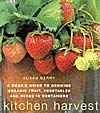 "Kitchen Harvest: Growing Organic Fruit, Vegetables & Herbs in Containers" by Susan Berry, Frances Lincoln, 2003, ISBN 9780711221352
"Kitchen Harvest: Growing Organic Fruit, Vegetables & Herbs in Containers" by Susan Berry, Frances Lincoln, 2003, ISBN 9780711221352
Grow organic vegetables and fruit, even if you don't have a garden: all you need is a couple of pots or a window box. Explores which are the best plants for maximum yield; how to provide the best conditions; and how to plan for a succession of edible plants. Includes recipes. Color photos and illustrations. 144 pages. Buy at Amazon.com: Kitchen Harvest
"McGee & Stuckey's Bountiful Container: Create Container Gardens of Vegetables, Herbs, Fruits, and Edible Flowers" by Rose Marie Nichols McGee, Maggie Stuckey, Workman Publishing, 2002, ISBN 0761116230
McGee, author of Basic Herb Cookery, and veteran gardening writer Stuckey (Gardening from the Ground Up) share their expertise and experience in the art of container gardening. How to grow foods on a balcony, porch, front or back steps, even in a window box or on an indoor windowsill. Detailed information on types of containers, equipment needed, soil, sun and water, fertilizer, seeds and propagation, also advanced techniques such as succession planting. Includes recipes. For beginners and experienced gardeners. Complete, plant-by-plant guide, vegetables, herbs and fruits. Reader comment: "I now have a flourishing garden full of lettuce, beans, squash, tomatoes, and strawberries." Illustrated, 400 pages. Buy at Amazon.com: McGee & Stuckey's Bountiful Container
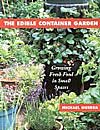 "The Edible Container Garden: Growing Fresh Food in Small Spaces" by Michael Guerra, Fireside, 2000, ISBN 0684854619
"The Edible Container Garden: Growing Fresh Food in Small Spaces" by Michael Guerra, Fireside, 2000, ISBN 0684854619
British permaculturist Michael Guerra promises fresh-tasting, pesticide-free produce, and the chance to grow a luscious array of fruits and vegetables not available at the supermarket, all in small raised beds, pots, or window boxes. Salad greens, savory herbs, fruits and vegetables for the patio, balcony, or rooftop. Reader comment: "The deck outside our front door is now inhabited by a very good herb garden, pots of courgettes with broad dark green leaves and beautiful yellow flowers, Japanese greens and a tomato vine, making cooking with fresh produce as easy as stepping out the kitchen door for a moment. A very useful book." 160 pages. Buy at Amazon.com: The Edible Container Garden
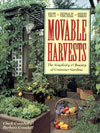 "Movable Harvests -- The Simplicity & Bounty of Container Gardens" by Chuck Crandall & Barbara Crandall, Chapters, 1995, ISBN 1-881527-70-0
"Movable Harvests -- The Simplicity & Bounty of Container Gardens" by Chuck Crandall & Barbara Crandall, Chapters, 1995, ISBN 1-881527-70-0
Anything that grows in a conventional garden can be grown in a container, fruits and berries, salad greens and root vegetables -- even asparagus, pumpkins, corn, and apples, apricots, peaches, pears, figs, and bananas. The authors, seasoned "bucket gardeners", grow 90% of their produce in a variety of containers. Lots of useful advice from the experts. For city-dwellers and small gardeners everywhere. Buy at Amazon.com: Movable Harvests
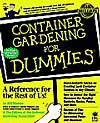 "Container Gardening for Dummies" by Bill Marken, The Editors of the National Gardening Association, 1998, ISBN 0764550578
"Container Gardening for Dummies" by Bill Marken, The Editors of the National Gardening Association, 1998, ISBN 0764550578
The ultimate guide to growing almost anything in a container on roofs, balconies, or windowsills, written by leading gardening journalist Bill Marken and the experts of the US NGA. Choosing containers, fertilizing and watering techniques, dealing with insects, pests, and diseases, clear, concise, step-by-step instructions for creating container gardens in any climate. For beginners or experienced gardeners. 16 pages of photos, 384 pages. Buy at Powell's Books:
http://www.powells.com/biblio/1-9780764550577-0
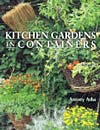 "Kitchen Gardens in Containers" by Anthony Atha, Collins & Brown, 2002, ISBN 080699293X
"Kitchen Gardens in Containers" by Anthony Atha, Collins & Brown, 2002, ISBN 080699293X
Dozens of different ways to grow fruit and vegetables in containers. The second half of the book is a plant directory, color-coded, divided into herbs, vegetables and fruit, with light requirements, propagation needs and other information, and recipes for each plant. The book is well presented and well illustrated, practical and useful information for gardeners with intermediate skills. 160 pages. Buy at Powell's Books:
http://www .powells.com/biblio/1-9780806992938-4
 "Little Herb Gardens: Simple Secrets for Glorious Gardens -- Indoors and Out" by Georgeanne Brennan, Mimi Luebbermann, Faith Echtermeyer, Chronicle Books, 1993, ISBN 0811843092
"Little Herb Gardens: Simple Secrets for Glorious Gardens -- Indoors and Out" by Georgeanne Brennan, Mimi Luebbermann, Faith Echtermeyer, Chronicle Books, 1993, ISBN 0811843092
Friendly guide to homegrown herbs by three experienced garden writers. Perfect for beginners. Grow productive herb gardens year round in even the smallest spaces. Growing instructions over 30 herbs. Herb-by-herb description of how to grow the plants, organized according to where you could keep them -- on a windowsill or fire escape, inside porch, outdoor pots, pantry, etc. Recipes for culinary herbs, resource directory, a bibliography,seed and plant sources in the US. Colorful photographs, 96 pages. Buy at Powell's Books:
http://www.powells.com/biblio/2-9780811802499-2
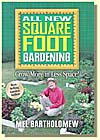 Container gardening with a difference -- The All New Square Foot Gardening Book, by Mel Bartholomew -- Many changes from the original, updates and upgrades, with easier to follow guides and an illustrated "How-To" and "Step-By-Step" approach anyone can understand. History of Square Foot Gardening, all the basic principles, quick start guide, expanded resources on recommended plants and charts showing growth rate and proper plant choice, and more. Buy at Amazon.com: All New Square Foot Gardening
Container gardening with a difference -- The All New Square Foot Gardening Book, by Mel Bartholomew -- Many changes from the original, updates and upgrades, with easier to follow guides and an illustrated "How-To" and "Step-By-Step" approach anyone can understand. History of Square Foot Gardening, all the basic principles, quick start guide, expanded resources on recommended plants and charts showing growth rate and proper plant choice, and more. Buy at Amazon.com: All New Square Foot Gardening
See Building a square foot garden
Container Vegetable Gardening by Bob Polomski, Extension Consumer Horticulturist, and Debbie Shaughnessy, Home & Garden Information Center Information Specialist, Clemson University, South Carolina -- from the South Carolina Master Gardener Training Manual. If you do not have space for a vegetable garden or if your present site is too small, consider raising fresh, nutritious, homegrown vegetables in containers. A windowsill, patio, balcony or doorstep can provide sufficient space for a productive container garden. Containers, media, fertilizing, planting, watering, general care. Linked to Vegetable Factsheets and other online resources.
http://hgic.clemson.edu/factsheets/hgic1251.htm
 Basics of Container Gardening by Stefani Leto, The New Homemaker
Basics of Container Gardening by Stefani Leto, The New Homemaker
Growing flowers and food in pots is easy -- Start with the soil, pick your plants, choose your container, food and water, bag those bugs!
http://www.thenewhomemaker.com/
containergardening
Container Gardening by John W. Jett, Extension Specialist, Horticulture, WVU Extension Service, West Virginia University -- While space (or lack of it) is an obvious reason to try container gardening, that is not the only reason people choose this method. Often, convenience plays a big part, especially for vegetables and herbs. Having these essentially at your fingertips is a tremendous advantage. Useful, sensible advice. Edibles (vegetables, herbs, fruits) and ornamentals (annual flowers, perennial flowers, exotic foliage, bulbs). Online:
http://www.wvu.edu/~agexten/hortcult/homegard/cntanegrd.htm
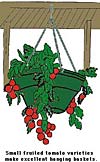 Vegetable Gardening In Containers, by Sam Cotner, Extension Horticulturist, Texas Agricultural Extension Service, Texas A&M University. If your vegetable gardening is limited by insufficient space or an unsuitable area, consider the possibility of raising fresh, nutritious, homegrown vegetables in containers. A window sill, a patio, a balcony or a doorstep will provide sufficient space for a productive mini-garden. Almost any vegetable that will grow in a typical backyard garden will also do well as a container-grown plant. Good general advice, varieties, troubleshooting.
Vegetable Gardening In Containers, by Sam Cotner, Extension Horticulturist, Texas Agricultural Extension Service, Texas A&M University. If your vegetable gardening is limited by insufficient space or an unsuitable area, consider the possibility of raising fresh, nutritious, homegrown vegetables in containers. A window sill, a patio, a balcony or a doorstep will provide sufficient space for a productive mini-garden. Almost any vegetable that will grow in a typical backyard garden will also do well as a container-grown plant. Good general advice, varieties, troubleshooting.
http://aggie-horticulture.tamu.edu/extension/container/container.htmlCity rooftop gardens
Growing gardens on city rooftops is a way to take back unused and sterile spaces and transform them into a valuable asset, for the building inhabitants and owners, for the community, for the city, and for the environment. Rooftop gardens make cities better places to live in.

-- Green Roofs for Healthy Cities
Whether they're lush green oases of grass, flowers and shrubs or urban mini-farms growing fresh local organic food, or a combination of the two, rooftop gardens reduce the ecological footprint of city buildings and of the cities themselves.
Rooftop gardens keep buildings much quieter inside, and much cooler in summer and warmer in winter, saving energy -- installation costs are soon recovered.
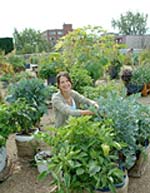
-- The Rooftop Garden Project
Rooftop gardens are the best solution to the urban "heat island" effect -- the gardens cool the unnaturally heated city air and clean it, filtering out the soot. (See Heat Island Effect, US EPA http://www.epa.gov/hiri/).
Rooftop gardens also cut right down on rainwater drainage -- the soil absorbs the rain and filters it, the plants expire the water back into the atmosphere. And rooftop gardens are oases for the city wildlife, providing habitats and helping to safeguard a threatened biodiversity.
Composting city organic wastes to provide the soil and fertility for rooftop gardens diverts it landfills and incinerators and returns it to nature where it belongs, in accordance with the "Law of Return" -- and composting and organic growing is the best way to sequester the carbon from the excessive greenhouse gas emissions that cities produce. See Compost and CO2.
Greening our cities, rooftops and all, could be a critical factor in helping our planet's struggling climate to find a balance in the new carbon-rich atmosphere we've created, rather than flipping out of control.
City rooftop garden resources
 The Rooftop Garden Project is dedicated to empowering urban residents in Montreal, Canada and around the world, "to produce their own food, green their neighbourhoods and build healthy communities". News, upcoming events, publications, media coverage, resources, links.
The Rooftop Garden Project is dedicated to empowering urban residents in Montreal, Canada and around the world, "to produce their own food, green their neighbourhoods and build healthy communities". News, upcoming events, publications, media coverage, resources, links.
http://rooftopgardens.ca/en
Rooftop Garden Brochure -- 4-page pdf:
http://rooftopgardens.ca/files/4pagerenglishWEB.pdf
 "Guide to Setting up Your Own Edible Rooftop Garden", The Rooftop Garden Project -- Step-by-step guide to creating your own rooftop garden. For groups, individuals and establishments that would like to create an urban edible rooftop garden for educational, social, therapeutic or environmental reasons. Six chapters cover the main factors to consider: project definition, choice of site, setting up the garden, coordination of gardening activity, health choices and a detailed technical guide on rooftop container gardening, plus annexes with descriptions of Rooftop Garden Project gardens and additional information. 80 pages. Download pdf:
"Guide to Setting up Your Own Edible Rooftop Garden", The Rooftop Garden Project -- Step-by-step guide to creating your own rooftop garden. For groups, individuals and establishments that would like to create an urban edible rooftop garden for educational, social, therapeutic or environmental reasons. Six chapters cover the main factors to consider: project definition, choice of site, setting up the garden, coordination of gardening activity, health choices and a detailed technical guide on rooftop container gardening, plus annexes with descriptions of Rooftop Garden Project gardens and additional information. 80 pages. Download pdf:
http://rooftopgardens.ca/files/howto_EN_FINAL_lowres.pdf
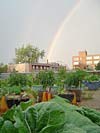 Making Rooftops Bloom: Strategies for encouraging rooftop greening in Montreal -- Rooftop Garden Project staffer Rotem Ayalon wrote his Master's thesis for a degree in Urban Planning on municipal strategies to encourage rooftop greening, focusing on food security policies and programs, urban agriculture and rooftop greening in North America and around the world. This is it:
Making Rooftops Bloom: Strategies for encouraging rooftop greening in Montreal -- Rooftop Garden Project staffer Rotem Ayalon wrote his Master's thesis for a degree in Urban Planning on municipal strategies to encourage rooftop greening, focusing on food security policies and programs, urban agriculture and rooftop greening in North America and around the world. This is it:
http://rooftopgardens.ca/files/
Making_Rooftops_Bloom_Final_Draft.pdf
Spreading the Roots: An assessment of the social and enviromental impacts of the Rooftop Garden Project by Rotem Ayalon, Rooftop Garden Project, 2006. Rooftop gardens bring positive benefits to the people in the city, but how much and what kind? Social and environmental impact study.
http://rooftopgardens.ca/files/SocEnvt%20Assessment_jan06_forweb.pdf
Roof gardens from City Farmer News, City Farmer -- Canada's Office of Urban Agriculture: News, project reports, photographs, resources.
http://www.cityfarmer.info/category/roof-garden/
 Greenroofs.com resource portal -- Large site with loads of information and resources: new events, forums, research, marketplace, greenroofs project of the week, greenroofs video of the week, and much more.
Greenroofs.com resource portal -- Large site with loads of information and resources: new events, forums, research, marketplace, greenroofs project of the week, greenroofs video of the week, and much more.
http://www.greenroofs.com/index.html
International Greenroof Projects Database, Greenroofs.com -- 683 Projects = 16,279,113 ft2. Search:
http://www.greenroofs.com/projects/plist.php
Greenroofs 101, Greenroofs.com -- "Our most popular section": a detailed FAQ, nuts and bolts information about the earth friendly technology of organic greenroof architecture.
http://www.greenroofs.com/Greenroofs101/index.html
Greenroofs.com Forums
http://www.greenroofs.com/forums/
 Green Roofs for Healthy Cities -- Green Roof Infrastructure Industry Association, focus on the US and Canada. Offers design courses in many North American cities, symposia, conferences, current events, news, media, education, Awards of Excellence.
Green Roofs for Healthy Cities -- Green Roof Infrastructure Industry Association, focus on the US and Canada. Offers design courses in many North American cities, symposia, conferences, current events, news, media, education, Awards of Excellence.
http://www.greenroofs.org/
About Green Roofs -- FAQ: Lengthy introduction to the benefits and advantages of green roofs.
http://www.greenroofs.org/index.php?option=
com_content&task=view&id=26&Itemid=40
The Green Roofs Tree of Knowledge is a full-featured database on research and policy related to green roof infrastructure. Detailed summaries of research and policy papers in English from around the world.
http://greenroofs.org/grtok/
Living Architecture Monitor magazine, published four times per year and available to GRHC members only. Subscribe:
http://www.greenroofs.org/index.php?option=
com_content&task=view&id=13&Itemid=41
Current issue:
http://www.greenroofs.org/index.php?option=
com_content&task=view&id=214&Itemid=91
 "Green Roofs for Healthy Cities -- Award-winning Green Roof Designs", by Steven W. Peck, founder and president of Green Roofs for Healthy Cities -- The award-winning roof designs described and illustrated with over 100 photographs, for private homes, businesses, and public spaces. Projects cover a wide geographic range from Manitoba to Florida, from the mid-Atlantic coast to the Pacific. Details about the plants used, growing media, drainage and irrigation systems, and waterproofing, along with descriptions of challenges and innovations.
"Green Roofs for Healthy Cities -- Award-winning Green Roof Designs", by Steven W. Peck, founder and president of Green Roofs for Healthy Cities -- The award-winning roof designs described and illustrated with over 100 photographs, for private homes, businesses, and public spaces. Projects cover a wide geographic range from Manitoba to Florida, from the mid-Atlantic coast to the Pacific. Details about the plants used, growing media, drainage and irrigation systems, and waterproofing, along with descriptions of challenges and innovations.
http://www.schifferbooks.com/newschiffer/
book_template.php?isbn=9780764330223
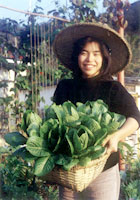
Midori carrying a one square foot basket with nine cos lettuces
City farms
Organic gardening
Why organic?
Building a square foot garden
Plant spacing guides
No ground? Use containers
When to sow what
Seeds
Garden pond
Gardening resources
Composting
Making compost
Composting resources
Composting indoors
Vermicomposting
Humanure
Composting for small farms
Small farms
Small farm resources
Community-supported farms
Farming with trees
Farming with animals
Pasture
Pigs for small farms
Poultry for small farms
Aquaculture for small farms
Composting for small farms
Controlling weeds and pests
Small farms library